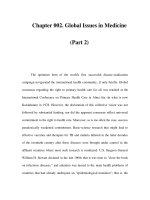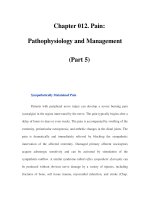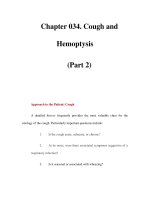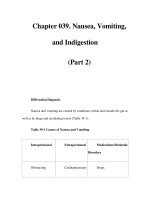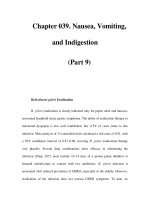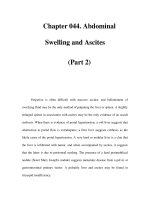Chapter 107. Transfusion Biology and Therapy (Part 2) pps
Bạn đang xem bản rút gọn của tài liệu. Xem và tải ngay bản đầy đủ của tài liệu tại đây (16.56 KB, 5 trang )
Chapter 107. Transfusion
Biology and Therapy
(Part 2)
Rh System
The Rh system is the second most important blood group system in
pretransfusion testing. The Rh antigens are found on a 30- to 32-kDa RBC
membrane protein that has no defined function. Although >40 different antigens in
the Rh system have been described, five determinants account for the vast
majority of phenotypes. The presence of the D antigen confers Rh "positivity,"
while persons who lack the D antigen are Rh negative. Two allelic antigen pairs,
E/e and C/c, are also found on the Rh protein. The three Rh genes, E/e, D, and C/c,
are arranged in tandem on chromosome 1 and inherited as a haplotype, i.e., cDE or
Cde. Two haplotypes can result in the phenotypic expression of two to five Rh
antigens.
The D antigen is a potent alloantigen. About 15% of individuals lack this
antigen. Exposure of these Rh-negative people to even small amounts of Rh-
positive cells, by either transfusion or pregnancy, can result in the production of
anti-D alloantibody.
Other Blood Group Systems and Alloantibodies
More than 100 blood group systems are recognized, composed of more than
500 antigens. The presence or absence of certain antigens has been associated with
various diseases and anomalies; antigens also act as receptors for infectious
agents. Alloantibodies of importance in routine clinical practice are listed in Table
107-1.
Table 107-1 RBC Blood Group Systems and Alloantigens
Blood
Group System
Antigen Alloantibody
Clinical
Significance
Rh (D,
RBC protein IgG HTR, HDN
C/c, E/e)
Lewis
(Le
a
, Le
b
)
Oligosaccharide
IgM/IgG Rare HTR
Kell
(K/k)
RBC protein IgG HTR, HDN
Duffy
(Fy
a
/Fy
b
)
RBC protein IgG HTR, HDN
Kidd
(Jk
a
/Jk
b
)
RBC protein IgG
HTR (often
delayed), HDN
(mild)
I/i Carbohydrate IgM None
MNSsU RBC protein IgM/IgG Anti-
M rare
HDN, anti-S, -
s, and
-U HDN, HTR
Note:
RBC, red blood cell; HDN, hemolytic disease of the newborn; HTR,
hemolytic transfusion reaction.
Antibodies to Lewis system carbohydrate antigens are the most common
cause of incompatibility during pretransfusion screening. The Lewis gene product
is a fucosyl transferase and maps to chromosome 19. The antigen is not an integral
membrane structure but is adsorbed to the RBC membrane from the plasma.
Antibodies to Lewis antigens are usually IgM and cannot cross the placenta. Lewis
antigens may be adsorbed onto tumor cells and may be targets of therapy.
I system antigens are also oligosaccharides related to H, A, B, and Le. I and
i are not allelic pairs but are carbohydrate antigens that differ only in the extent of
branching. The i antigen is an unbranched chain that is converted by the I gene
product, a glycosyltransferase, into a branched chain. The branching process
affects all the ABH antigens, which become progressively more branched in the
first 2 years of life. Some patients with cold agglutinin disease or lymphomas can
produce anti-I autoantibodies that cause RBC destruction. Occasional patients with
mononucleosis or Mycoplasma pneumonia may develop cold agglutinins of either
anti-I or anti-i specificity. Most adults lack i expression; thus, finding a donor for
patients with anti-i is not difficult. Even though most adults express I antigen,
binding is generally low at body temperature. Thus, administration of warm blood
prevents isoagglutination.
The P system is another group of carbohydrate antigens controlled by
specific glycosyltransferases. Its clinical significance is in rare cases of syphilis
and viral infection that lead to paroxysmal cold hemoglobinuria. In these cases, an
unusual autoantibody to P is produced that binds to RBCs in the cold and fixes
complement upon warming. Antibodies with these biphasic properties are called
Donath-Landsteiner antibodies. The P antigen is the cellular receptor of
parvovirus B19 and also may be a receptor for Escherichia coli binding to
urothelial cells.
